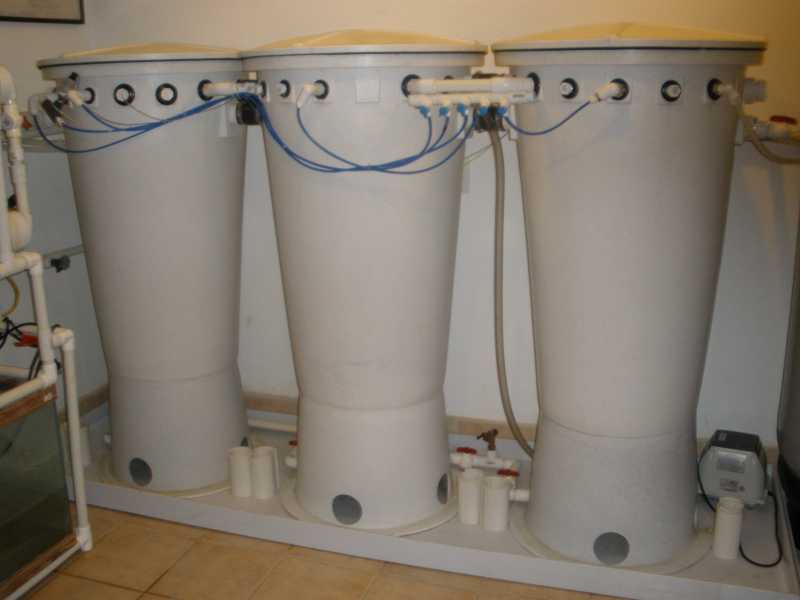- Forum
- categories
- Resource recovery
- Greywater, blackwater or wastewater reuse, irrigation
- Greywater Reuse for Irrigation Purposes
Greywater Reuse for Irrigation Purposes
6546 views
- clint
-

- User is blocked
- The Rain Man - El Hombre de La Lluvia
Less- Posts: 60
- Karma: 1
- Likes received: 16
Hole Mi Amigo,
Having worked with aerobic treatment of greywater for over 45 years I would recommend that you utilize at least a three chambered septic type tank or three separate tanks connected in series.
With minimal energy the first two chambers and/or tanks are aerated to immediately provide oxygen to the "Good" Guys, the aerobic ones!
By installing plumbing T's, in our case 2", at each interior effluent port, the fats and grease that floats remains in the tank to be eaten up by the "Good" Guys, and the heavy stuff settles to the bottom for easy removal with a bottom discharge for maintenance, in our tanks, or pipe installed to suck those settleable solids out to be further composted in a separate composting system for total resource recovery.
Google AlasCan and Equaris Corporation and you will find drawings of our greywater patented technologies if you wish to utilize a system that has proven its performance under Arctic and Caribbean conditions.
If you really want to get into it, think about ozone and reverse osmosis and total reuse of the greywater to drinking water qualities and then utilize the RO concentrate to irrigate and/or flush water consuming toilets.
El Hombre de La Lluvia
A basic septic tank works or even on a residential level three plastic 30 gallon or larger tanks connected in series.
Having worked with aerobic treatment of greywater for over 45 years I would recommend that you utilize at least a three chambered septic type tank or three separate tanks connected in series.
With minimal energy the first two chambers and/or tanks are aerated to immediately provide oxygen to the "Good" Guys, the aerobic ones!
By installing plumbing T's, in our case 2", at each interior effluent port, the fats and grease that floats remains in the tank to be eaten up by the "Good" Guys, and the heavy stuff settles to the bottom for easy removal with a bottom discharge for maintenance, in our tanks, or pipe installed to suck those settleable solids out to be further composted in a separate composting system for total resource recovery.
Google AlasCan and Equaris Corporation and you will find drawings of our greywater patented technologies if you wish to utilize a system that has proven its performance under Arctic and Caribbean conditions.
If you really want to get into it, think about ozone and reverse osmosis and total reuse of the greywater to drinking water qualities and then utilize the RO concentrate to irrigate and/or flush water consuming toilets.
El Hombre de La Lluvia
A basic septic tank works or even on a residential level three plastic 30 gallon or larger tanks connected in series.
Attachments:
-
 10-05-2014003.jpg
(Filesize: 25KB)
10-05-2014003.jpg
(Filesize: 25KB)
Please Log in to join the conversation.
You need to login to reply
Dear Marina,
This is an important issue, but we need to know more about the situation. What country is it? What is the climate? What crops are being grown?
At first glance, it seems the greywater could first pass through an Anaerobic Baffled Reactor (ABR) to separate solids, grease, and maybe even biogas. Next, if food crops that are eaten raw are to be irrigated, I would put the greywater through some sort of Vegetated Sand Filter (= Constructed Wetland, Phytoremediation) to control the pathogens and produce fodder for animals and potentially other useful products.
Please post more information on the case in question.
Best wishes,
Chris Canaday
This is an important issue, but we need to know more about the situation. What country is it? What is the climate? What crops are being grown?
At first glance, it seems the greywater could first pass through an Anaerobic Baffled Reactor (ABR) to separate solids, grease, and maybe even biogas. Next, if food crops that are eaten raw are to be irrigated, I would put the greywater through some sort of Vegetated Sand Filter (= Constructed Wetland, Phytoremediation) to control the pathogens and produce fodder for animals and potentially other useful products.
Please post more information on the case in question.
Best wishes,
Chris Canaday
Conservation Biologist and EcoSan Promoter
Omaere Ethnobotanical Park
Puyo, Pastaza, Ecuador, South America
inodoroseco.blogspot.com
Omaere Ethnobotanical Park
Puyo, Pastaza, Ecuador, South America
inodoroseco.blogspot.com
Please Log in to join the conversation.
You need to login to reply- MarinaAndj
-
 Topic Author
Topic Author- User is blocked
Less- Posts: 3
- Likes received: 1
Dear all,
In our project area, we are generating 35 MLD greywater daily.
What is the best technology available to treat greywater and reuse for irrigation purposes?
I would like to know the feasibility of these technologies, as well as economical details.
Please share your case experiences and treatment details.
Thank you!
Originally posted on The Water Network: bit.ly/2drx7IW
In our project area, we are generating 35 MLD greywater daily.
What is the best technology available to treat greywater and reuse for irrigation purposes?
I would like to know the feasibility of these technologies, as well as economical details.
Please share your case experiences and treatment details.
Thank you!
Originally posted on The Water Network: bit.ly/2drx7IW
Please Log in to join the conversation.
You need to login to reply
Share this thread:
- Forum
- categories
- Resource recovery
- Greywater, blackwater or wastewater reuse, irrigation
- Greywater Reuse for Irrigation Purposes
Recently active users. Who else has been active?
Time to create page: 0.075 seconds








